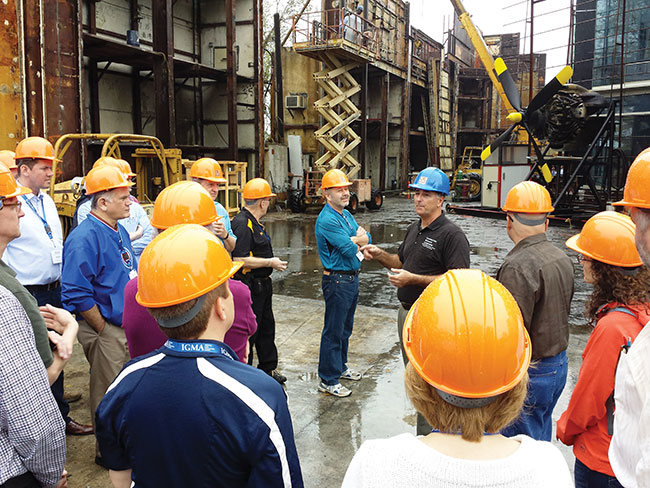
Features
Community
Event reports
Pushing knowledge
The IGMA Winter Conference seeks to advance the industry with new standards for vacuum insulating g
March 23, 2015 By Margaret Webb
IGMA’s 2015 Winter Conference was held the first week of February in Fort Lauderdale, Fla.
IGMA’s 2015 Winter Conference was held the first week of February in Fort Lauderdale, Fla. In addition to the technical meetings, highlights included a visit to Construction Research to witness full mock-up testing.
 |
|
| IGMA delegates toured Construction Research Lab in Miami, Fla. Established in 1955, Construction Research says it was the first company in the world to build a curtain wall test facility. Today, the company has 38 test chambers with testing capacity up to 40 feet high.
|
A new board of directors was approved with the following slate of officers:
- President: Mark Hutchinson, Intigral
- Past President: Frank Caporiccio, PPG Canada
- Vice President: Nathalie Thibault, Prelco
- Treasurer: Jennifer Kempf, Dow Corning
- Secretary: Helen Sanders, Sage Electrochromics
In addition to electing the new board of directors, two honorary, lifetime memberships were awarded to Denny Raske (Allmetal) and Bob Spindler (Cardinal IG), both retired. Honorary, lifetime memberships allow these individuals to attend all future IGMA conferences on a complimentary basis and continue to receive all IGMA updates.
Emerging Technology and Innovation
The Emerging Technology and Innovation Committee is chaired by Helen Sanders of Sage Electrochromics. The Advanced Testing Fenestration task group is working on three new test protocols designed to correlate to the ASTM standards and provide a faster means of testing: The first of these is Positive Negative Pressure Cycling, also known as the Thumper. This equipment uses external pressure modulation of plus then minus one pound per square inch to replicate the pressure changes witnessed within an IGU cavity. Variable Environmental Cycling (Oscar), uses a modified P1 chamber with full immersion UV at 100 per cent relative humidity and 60 C pressurized to five psi. Finally, Differential Thermal Cycling Unit (Big Hammer) was developed by the U.S. National Renewable Energy Laboratory (NREL). This equipment uses rapid thermal cycling to replicate thermal cycles in ASTM E2188. The group is currently evaluating the fabrication of “flawed” test samples to determine equivalency to the ASTM standard. Currently this group is working on how to correlate the NREL thermal chamber and the two other test methods with the ASTM E 2190 standard to ensure that the new test procedures will meet or exceed the objectives in the existing standard. NREL now has the capability to frost point the units as well as measure the gas content.
The Vacuum Insulating Glazing task group has completed the first two objectives under their scope. An extensive library has been established of existing vacuum insulating documents and is available to IGMA members as a reference center.
The group has developed a technical bulletin on vacuum insulating glass (VIG) and this document has passed committee ballot and Technical Policy Committee ballot. The IGMA board of directors’ ballot is being developed. We are anticipating publication of this document in mid-summer. Work is ongoing to develop a European (EN) standard. IGMA will be monitoring the progress of this development and a number of IGMA members are participating on this task group. Currently, VIG units are being tested under the IGCC-IGMA Certification Program to the ASTM E 2190 standard. Full certification guidelines will be developed once the standard specification has been completed. The IGMA Glazing Guidelines working group has been assigned to develop glazing guidelines for VIG.
The Product Category Rule for fenestration products has been split into two PCR’s, one for business-to-consumer, which will be a cradle-to-cradle, and the second for business-to-business, which is a cradle-to-gate PCR. Both PCR’s are identical in the cradle-to-gate section. The Use phase has been completed and the section forwarded to the PCR operator, the Institute for Environmental Research and Education, for review. The PCR is now subject to peer review and is anticipated to be ready for publication this summer. IGMA has awarded the contract for the development of the Processed Glass PCR to UL Environment. The timeline is ambitious (six months from commencement of the work) for the development of one core PCR with three modules: one for coated and heat-strengthened glass, a second one for laminated glass and the third for insulating glass. Work will be commencing this spring.
The parameters for the Gas Content Field Correlation Study have been established and the task group is now researching appropriate tools for the measurement of gas content at the point of manufacture, installation and ongoing evaluation.
Technical Services
The Technical Services Committee was chaired by Jeff Haberer of Trulite. It heard that work has been completed for the technical bulletin on setting blocks and has been published. The board of directors ballot on Section 5: Setting Blocks is under development pending completion of the diagrams to facilitate future revisions.
 |
|
| It’s not all shop talk, even at a technical conference. Frank Caporiccio of PPG and Dave Devenish of Fenzi get into the island theme.
|
Reporting on the Thermal Stress task group activities, Bill Lingnell, IGMA’s technical consultant, provided an update on the development of models for the calculation of thermal stress in insulating glass units. Work is well under way and it is anticipated that all models will be completed by the end of 2015. Once this work has been completed, it will be shared with the ASTM task group so that work can commence on the development of a thermal glass standard specification for thermal stress in insulating glass units.
The scope of the Tolerances for IG Cavity Width task group is to address non-parallel glazing and the effect on thermal and long-term performance related to changes in the cavity width. The task group met early October and established three work groups.
The Manufacturing Tolerances working group will develop and establish manufacturing tolerances for allowable deflection at the point of manufacture. There are a number of factors that influence IGU performance which are beyond the control of the fabricator. A survey has been circulated to the IGMA manufacturing members to understand current in-plant practices. Guidelines for manufacturing tolerances will be developed from best practices.
The Thermal working group is working on developing information which correlates the IGU cavity width with thermal performance and how changes in the cavity width impact U-factor.
The Impact of Reflectance working group is reviewing existing available industry data. The scope and objectives of this group are under discussion.
The Dimensional Tolerances task group has developed a first draft of the revised document and has included glass edge alignment as an additional tolerance. The task group will meet one more time and then a committee ballot will be issued.
Canadian standards development
The Canadian General Standards Board has reconvened the CGSB Glass Committee. The committee has established four task groups to work on the CGSB 12.1 standard for safety glazing and the existing standard will be expanded beyond laminated and tempered glass to included organic coated and plastic safety glazing. The task groups are working closely with other organizations including the ANSI Z 97.1 group to harmonize safety glazing requirements. The first draft of the standard will be reviewed by the full glass committee mid-May 2015.
Certification and Education
Bill Briese of GED Integrated Solutions chairs the Certification and Education Committee. Their Sealant Adhesion to Spacer work group has developed a new test methodology based on a modification to the existing butterfly test. The test method has been approved by the full committee and the video will be re-filmed with an emphasis on handling glass safely. Now that this work has been completed and accepted, the Spacer and Integrated Spacer System task group will re-convene to continue development of equivalency criteria for spacers based on performance.
The TM-4000 Quality Manufacturing task group has completed the first draft for its revised manual. This revision includes all clauses for accreditation to the ISO 9001:2008 standard specific to IG manufacturing. Additionally, each section includes a commentary on the purpose and objectives so that manufacturers can determine which sections are relevant to their manufacturing operations and those from which they can be exempted. Substantial negatives were received on the first committee ballot and the task group will be reviewing these, revising the draft document as required and re-issuing a committee ballot.
The conference also heard from Arlene Stewart of AZS Consulting about upcoming changes to the Florida energy code. Florida’s energy standards often drive other standards in the southern U.S.
The IGMA 2015 Summer Conference will be held in the Denver, Colo., area with a site visit to the National Renewable Energy Laboratory (NREL) to view the Big Hammer and other research initiatives. The conference is scheduled for Sept. 29 to Oct. 2. The next IGMA Winter Conference will be held in Palm Springs, Calif., Feb. 29 to March 4, 2016.
Print this page
Leave a Reply